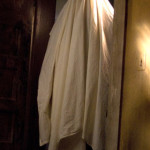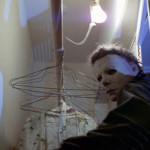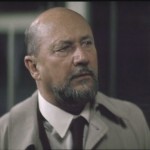John Carpenter‘s Halloween was among the first mainstream slasher movies, with the original Friday the 13th following hot in its wake. Both spawned a host of forgettable sequels and remakes to resurrect their respective bogeymen, Michael Myers (be masked) and Jason Voorhees (hockey mask), and an interminable array of me-too slasher pics followed in their wake.
That I remember Halloween fondly is much more to do with history. I saw it in 1978 when Nigel, my friend from back home in Manchester, came to visit me at university in Nottingham. In those days almost every feature came with a B-movie on the same bill, which in this case was a Spanish-Italian zombie epic called The Living Dead From The Manchester Morgue – which was actually set largely in the Lake District. All good fun, but it was merely the warm-up act for Halloween, the movie that had created a true buzz.
The first good sign was the presence of Pleasence, Donald Pleasence to be precise, an actor who made waves by playing Ernst Stavro Blofeld in You Only Live Twice, and developed a habit of either playing creepy characters, or making creepy any character he happened to be playing. In this case, Dr Sam Loomis is the good guy, but as the solitary Brit in an American movie will look menacing to most Americans watching. He was a fine actor and deserves credit for being good in every movie in which he appeared.
However, the myth that “scream queen” Jamie Lee Curtis (who happens to be one year to the day older than me) was “unknown” at the time she appeared in Halloween does not stand up to close scrutiny. You would hardly expect the daughter of Tony Curtis and Janet Leigh not to have at least a partial leg-up in the industry, though she has steadfastly made her own way and escaped the legacy of Laurie Strode. That said, the three movies she made with Carpenter certainly helped to launch the name of Jamie Lee Curtis. But as the producer Debra Hill put it:
“I knew casting Jamie Lee would be great publicity for the film because her mother was in Psycho.”
Cast notwithstanding, the whole scenario felt promising: Pleasence as the psychiatrist and Curtis as the “sensible” high school student whose friends and boyfriends are progressively murdered by the shadowy now-you-see-him-now-you-don’t serial killer Michael Myers, whose real name (Nick Castle) was kept remarkably quiet (perhaps the idea was to persuade the public Myers was a real person?)
At any rate, the plot was simple enough: young boy kills sister on Halloween and is locked up in an institution for the criminally insane. On the anniversary of the murder he escapes, so Loomis is in hot pursuit, apparently the only person who knows where Michael will go. Sure enough, in a stolen car Michael is kerb-crawling to track down some luscious lovelies to kill, then stalking them to play games of hide and seek and thereby unnerve them (and us). The unwitting victims set themselves up to be offed one at a time, but against all the odds Laurie (and the smaller children she seeks to protect) survive. Loomis thinks he has killed Michael, but of course the killer lives to slash another day.
In hindsight you might describe this as a formulaic movie, but then Carpenter took the cues of the master, Hitchcock, and created the blueprint for this formula. Sure there might have been some others, but previously the ground rules for this genre had not been codified. Thereafter you can see them everywhere, all following the Carpenter pattern: the false shocks, the creepy music, the camera angles, the glimpses of the bogeyman, the naive victim, the sudden kill… we are now so familiar with the language of the slasher movie, yet it still spooks us to this day.
The thing that makes it work so well here is the skill of Carpenter. Courtesy of Wikipedia:
Historian Nicholas Rogers notes that film critics contend that Carpenter’s direction and camera work made Halloween a “resounding success”. Roger Ebert remarks, “It’s easy to create violence on the screen, but it’s hard to do it well. Carpenter is uncannily skilled, for example, at the use of foregrounds in his compositions, and everyone who likes thrillers knows that foregrounds are crucial ….”
The opening title, featuring a jack-o’-lantern placed against a black backdrop, sets the mood for the entire film. The camera slowly moves toward the jack-o’-lantern’s left eye as the main title theme plays. After the camera fully closes in, the jack-o’-lantern’s light dims and goes out. Film historian J.P. Telotte says that this scene “clearly announces that [the film’s] primary concern will be with the way in which we see ourselves and others and the consequences that often attend our usual manner of perception”. During the conception of the plot, Yablans instructed “that the audience shouldn’t see anything. It should be what they thought they saw that frightens them”. Carpenter seemingly took Yablans’ advice literally, filming many of the scenes from Michael Myers’s point-of-view that allowed audience participation. Carpenter is not the first director to employ this method or use of a steadicam; for instance, the first scene of Psycho offers a voyeuristic look at lovers in a seedy hotel. Telotte argues, “As a result of this shift in perspective from a disembodied, narrative camera to an actual character’s eye … we are forced into a deeper sense of participation in the ensuing action”. Along with the 1974 Canadian horror film Black Christmas, Halloween made use of seeing events through the killer’s eyes.
The first scene of the young Michael’s voyeurism is followed by the murder of Judith seen through the eye holes of Michael’s clown costume mask. According to one commentator, Carpenter’s “frequent use of the unmounted first-person camera to represent the killer’s point of view … invited [viewers] to adopt the murderer’s assaultive gaze and to hear his heavy breathing and plodding footsteps as he stalked his prey”.Another technique that Carpenter adapted from Alfred Hitchcock‘s Psycho (1960) was suspense with minimal blood and gore. Hill comments, “We didn’t want it to be gory. We wanted it to be like a jack-in-the box.” Film analysts refer to this as the “false startle” or “the old tap-on-the-shoulder routine” in which the stalkers, murderers, or monsters “lunge into our field of vision or creep up on a person.” Carpenter worked with the cast to create the desired effect of terror and suspense. According to Curtis, Carpenter created a “fear meter” because the film was shot out-of-sequence and she was not sure what her character’s level of terror should be in certain scenes. “Here’s about a 7, here’s about a 6, and the scene we’re going to shoot tonight is about a 9½”, remembered Curtis. She had different facial expressions and scream volumes for each level on the meter.[
Carpenter’s direction for Castle in his role as Myers was minimal. For example, when Castle asked what Myers’ motivation was for a particular scene, Carpenter replied that his motivation was to walk from one set marker to another. The documentary titled Halloween Un-masked, featured in the 22nd anniversary DVD of Halloween, John Carpenter states he also instructed Castle to tilt his head a couple of times as if he was observing the corpse, particularly in the scene when Myers impaled one of his victims against a wall.









